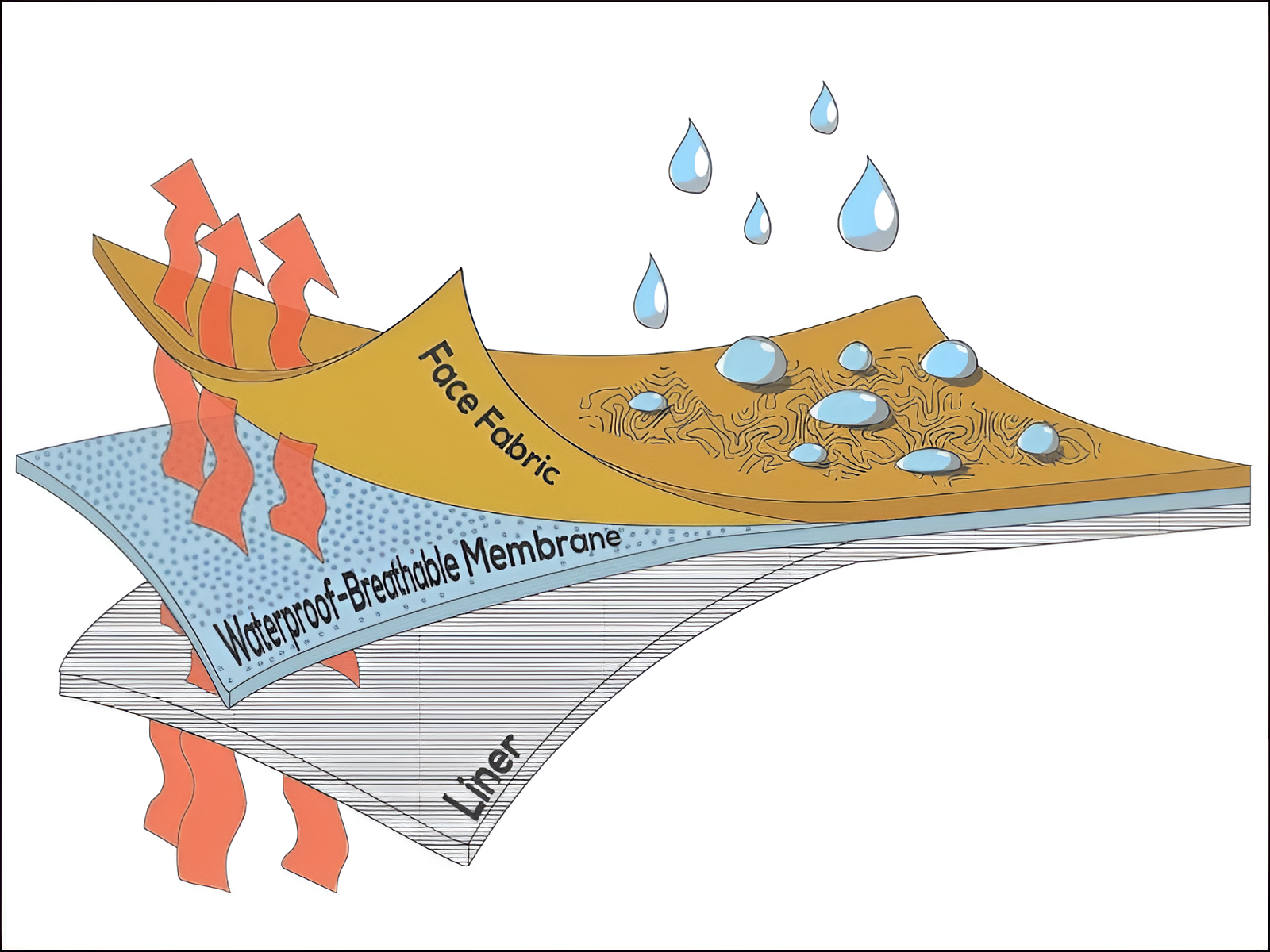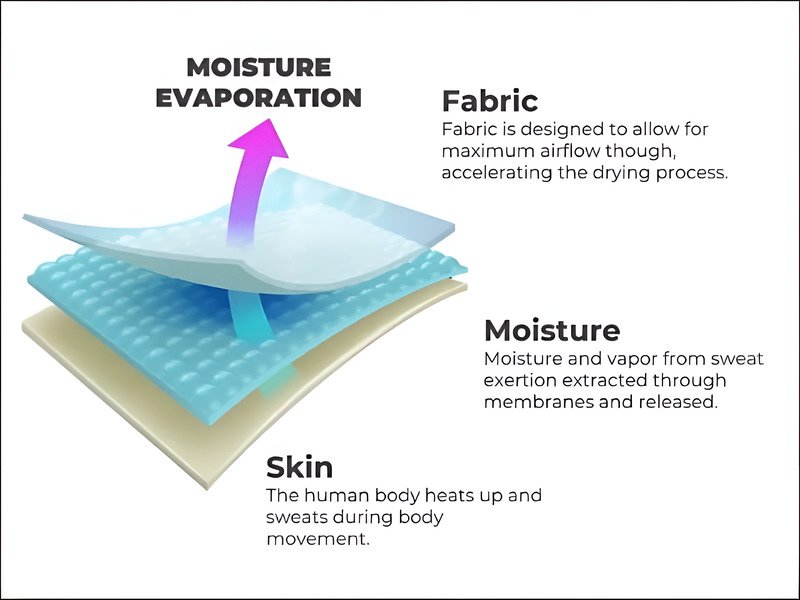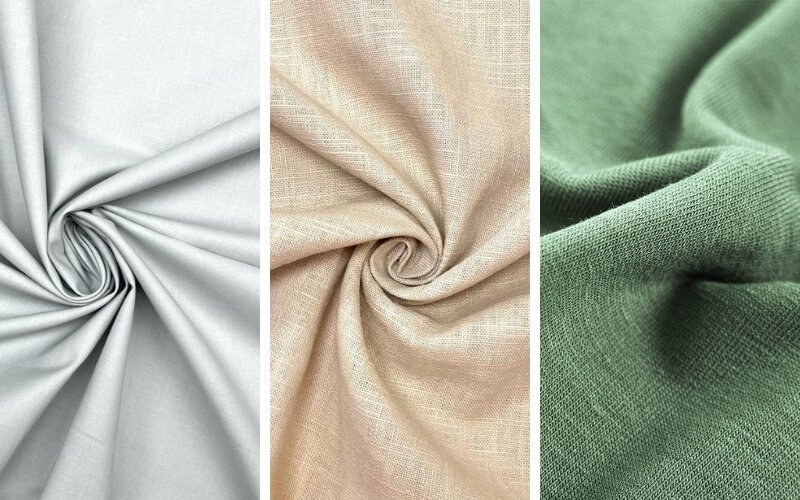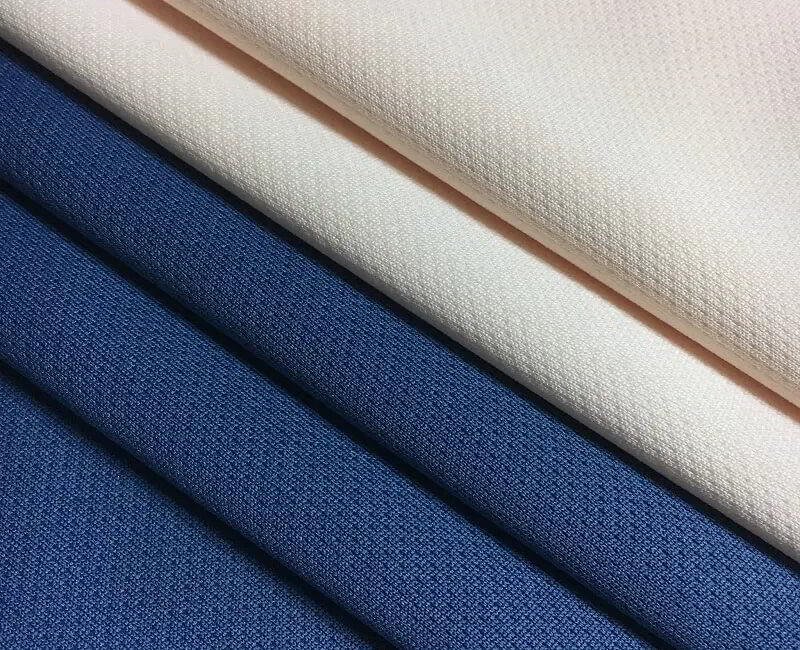What is Breathable? Meaning, How it Works And Top Fabrics
Ever feel hot, sweaty, and uncomfortable in your clothes, especially when it’s warm or you’re moving around? The problem might be what your clothes are made of! In simple terms, “breathable” materials let air move easily through them. They also help sweat escape from your skin, so you don’t feel wet or damp.
Think of it as your clothes letting your skin ‘breathe.’ The basic idea of ‘breathable’ is about good airflow and letting moisture escape.
This matters because it directly impacts how comfortable you feel in your clothes. Knowing about breathability helps you choose clothes that will keep you comfortable in different situations, like hot weather or when you exercise. If you make or sell clothes, choosing breathable fabrics can make your customers happier with your products.
1. What is breathable?
1.1 Defining “breathable” for everyone
A key part of a material being breathable is that it lets air pass through it from one side to the other. Imagine a sieve that lets water through but not sand; a breathable fabric lets air through. Tiny openings or the way fibers are arranged allow this.
So, the most basic definition of what is breathable is a material that air can flow through. This air moves through small spaces in the fabric’s structure. These materials are key to comfort. Breathability isn’t just about air; it’s very much about letting moisture (your sweat) escape.
Good breathable fabrics help your sweat turn into water vapor (a gas). This vapor can then pass through the fabric and away from your skin. This is crucial for feeling dry. Non-breathable fabrics, on the other hand, trap sweat as liquid. This ability to let sweat escape is sometimes measured by its moisture vapor transmission rate (MVTR), which is simply how quickly sweat vapor can escape.

1.2 Think of it like a window for your skin
Imagine your clothes are like tiny windows for your skin. Breathable fabrics open those windows to let fresh air in and damp, stuffy air out. This simple idea of clothing air circulation is what makes you feel much more comfortable.
2. Why are breathable materials so good for you?
2.1 More comfort
When sweat evaporates from your skin, it takes heat with it, which naturally cools you down. Breathable fabrics help this evaporation happen well by allowing moisture vapor to escape and air to circulate. This helps with thermal regulation (helping your body stay at a comfortable temperature). Non-breathable fabrics trap sweat, preventing this cooling evaporation and making you feel hotter and stickier.
Because sweat can turn into vapor and pass through the fabric, your skin and the fabric itself stay drier. This prevents that uncomfortable feeling of wet, heavy clothes clinging to you. You feel less sweaty with breathable clothes because the sweat can escape as vapor. Some fabrics also have moisture wicking properties (they help pull sweat away from your skin to the fabric surface), which further helps you stay dry.
2.2 Better for your skin
When sweat and moisture are trapped against your skin for long periods by non-breathable fabrics, it can lead to skin irritation, itchiness, chafing, or even rashes. Breathable fabrics reduce this risk by helping to keep your skin drier and allowing it to “breathe.”
They can help reduce the risk of sweat-related irritation, promoting better skin health. Simply put, dry skin generally feels much more comfortable than skin that is damp, clammy, or sticky. This directly leads to an overall improved wearing experience, one of the key apparel comfort factors when choosing breathable materials.

2.3 Good for activities
During exercise, your body produces much more sweat. Breathable sportswear is essential for managing this. It helps athletes stay cooler, drier, and more comfortable, which can improve performance. Breathability is important for sports clothes because it manages heavy sweat and maintains comfort during activity.
Babies’ skin is very sensitive, and they are less able to regulate their body temperature compared to adults. Breathable baby clothes help prevent babies from overheating and reduce the risk of skin irritation or heat rash. The importance of breathable materials in children’s clothing cannot be overstated for their comfort and well-being.
3. How do breathable fabrics work?
3.1 It’s about letting air and water vapor (tiny water particles) move
The structure of the fabric—how it is woven or knitted—plays a big role in its airflow. Some fabrics have a naturally more open construction with tiny spaces or channels between the yarns. These spaces allow air to pass through. This is different from large, visible holes like in mesh, but more about the micro-structure. Air physically gets through the fabric via these small spaces in the weave or knit.
This is related to the fabric’s porosity (tiny openings or pores in the fabric structure that allow air and moisture vapor to pass through). Wicking is a special property of some breathable fabrics. Wicking fabrics are designed to pull liquid sweat away from your skin’s surface and spread it across a larger area on the fabric’s outer surface.
Think of it like a paper towel soaking up water. This moves moisture away from the skin, helping you feel drier. Once moisture is wicked to the outer surface of the fabric and spread out, it can evaporate (turn into vapor) more easily and quickly. If the fabric also allows air to pass through, this air movement helps carry the moisture vapor away. This whole process (wicking + evaporation through a breathable structure) is what helps keep you dry and comfortable. The sweat, after being wicked, spreads out and evaporates into the air, and the moisture vapor transmission rate (MVTR) indicates how fast this can happen.

3.2 It’s not just about holes; it’s about the material’s ability to manage moisture
While some highly breathable fabrics like mesh have very obvious, visible holes for maximum airflow, many other moisture-managing textiles don’t. For these other materials, breathability comes from a combination of the type of fiber used, the fabric’s construction, and wicking properties.
It’s more complex than just having holes; the actual mechanism of fabric breathability involves these combined factors. In essence, breathable fabrics facilitate air and moisture exchange through these combined features.
4. Examples of breathable materials

4.1 Very breathable natural materials
- Cotton: Cotton is a soft, common natural fiber. The natural structure of cotton fibers allows air to circulate, making it breathable. It’s great for t-shirts, casual wear, underwear, and bedsheets. However, it can hold moisture if you sweat a lot and might feel damp, unless it’s a special type of cotton designed for performance.
- Linen: Linen is made from the flax plant and is known for being strong and getting softer with use. Linen typically has a looser, more open weave structure which allows for excellent airflow, making it feel very cool and airy. This makes it a great choice for summer shirts, dresses, and pants.
- Bamboo fabric (rayon/viscose from bamboo): Bamboo fabric, often rayon or viscose made from bamboo pulp, is typically very soft, smooth, and has a nice drape. It is generally good at allowing air and moisture to pass through, contributing to comfort. Common uses include t-shirts, sleepwear, socks, and underwear.
4.2 Breathable man-made materials
- Performance polyester/synthetics: Not all polyester is breathable; standard polyester can trap heat. However, performance polyester or technical synthetics are specifically engineered for sportswear and activewear. These are designed to have good wicking properties (pulling sweat away) and to dry quickly, enhancing their breathable feel.
- Mesh: Mesh fabric has visible small holes or a net-like structure. These holes allow for a very high degree of airflow. Mesh fabric is common in sports jerseys, panels in activewear, bags, and parts of shoes for ventilation.
- Tencel™ Lyocell: Tencel™ Lyocell (Tencel™ is a brand name for Lyocell) is a type of rayon made from wood pulp, often produced in an eco-friendlier way. It’s known for being very soft, smooth, gentle on sensitive skin, and also breathable and good at managing moisture. Common uses include clothing (dresses, shirts, activewear), bedding, and intimate apparel.
4.3 Less breathable / non-breathable materials
Here are a few examples of fabrics that are generally NOT breathable, to help you understand the difference:
- Regular (non-performance) polyester: Basic polyester that isn’t specially made for wicking or airflow can trap heat and moisture, making you feel clammy because it doesn’t let sweat vapor escape easily.
- Nylon: Standard nylon, like basic polyester, can also be less breathable. It’s strong but can trap heat. Some nylons are engineered for performance, but basic versions are not.
- Plastic or rubber coatings: Think of a classic raincoat. These are waterproof but typically stop air and sweat vapor from getting out, making you feel sweaty. This illustrates the common trade-off: full waterproofing often sacrifices breathability unless it’s a specialized ‘waterproof breathable’ fabric.
5. What makes a fabric breathable (or not)?
5.1 Fiber type
The type of fiber is a big factor. Fibers from natural sources like plants (cotton, linen) or animals (wool, silk) often have physical structures that help breathability. Natural materials often breathe better due to their inherent fiber structure.
Many basic synthetic fibers like standard polyester or nylon are made from plastics and tend to have smooth, solid filaments that don’t naturally allow much air or moisture through. However, these fibers can be engineered. Their shape can be changed, or they can be treated with finishes to improve wicking and breathability, especially for activewear. So, man-made fabrics can be breathable if specially engineered or treated.
5.2 Fabric construction
The fabric construction is crucial. How threads are interlaced (woven) or looped (knitted) impacts breathability. A looser weave (like some linens) or a more open knit structure creates more spaces for air. A very tight, dense weave reduces airflow.
How the fabric is woven or knitted makes a big difference; looser structures are more breathable. Generally, thinner fabrics allow more air to pass through more easily than very thick, heavy fabrics, assuming other factors are similar.

5.3 Finishes or coatings
Fabrics are sometimes treated with chemical finishes or coated to give them properties like waterproofing. While useful, these finishes can sometimes block or seal the tiny pores in the fabric, reducing its ability to let air and moisture pass through. Some treatments on fabrics can stop them from being breathable.
6. Breathable labels: A small detail that matters for comfort
6.1 Even labels can affect how a garment feels and breathes
When you’re choosing breathable materials for clothing, you don’t want an uncomfortable label to spoil it! A stiff, thick, or non-breathable label can trap a small amount of heat and sweat right against the skin. It can also feel scratchy, especially on sensitive skin or in activewear. A bad label can create a hot, sweaty, or itchy spot.
6.2 Why choose breathable or comfort-focused labels for breathable clothes
A soft, flexible, or tagless label complements the breathable fabric of the garment. It works with the main fabric’s properties.
The last thing you want is an itchy label spot when the rest of the garment feels great. A comfort-focused label avoids this.
6.3 Packlove’s options for breathable garments
At Packlove, we offer several label solutions designed to complement breathable apparel without sacrificing comfort:
- Woven labels: We can produce these with finer, softer threads and more flexible weaves, like damask. This makes them less noticeable against the skin and allows for better airflow.
- Heat transfer labels: As they are printed directly onto the garment, there is no extra material to cause irritation or block airflow. This makes them an excellent choice for sportswear, baby clothes, and any item where comfort is paramount.
Our team has extensive experience working with activewear and children’s clothing brands and can recommend the best label material and application method, such as specific heat transfer formulations that stretch with the fabric, to ensure complete comfort.

7. Quick tips for choosing and caring for breathable items
Here are a few tips to help you pick breathable clothes and keep them in good shape:
- Read fabric labels: When shopping, check the label for material composition. Look for cotton, linen, Tencel™, or specific performance polyesters.
- Feel the fabric: Does it feel light and airy? Does it seem like air could pass through?
- For activewear, look for terms: Look for keywords like ‘moisture-wicking,’ ‘breathable,’ or ‘quick-dry.’
- Care instructions: Some special breathable fabrics might have specific care instructions. For example, avoid fabric softeners as they can clog pores. Always check the care label. Properly caring for breathable clothing helps maintain its properties and ensures longevity.

8. Frequently asked questions (FAQs) about breathable materials
8.1 Is all cotton breathable?
Mostly, yes, cotton is naturally breathable. Its structure allows air to pass. However, very tightly woven cotton or cotton with certain chemical finishes might be less breathable. For everyday clothing, cotton is generally a good choice.
8.2 Are waterproof fabrics breathable?
This can be tricky! Traditional waterproof materials (like old plastic raincoats) aren’t breathable. However, modern ‘waterproof breathable’ fabrics (like Gore-Tex®) have microscopic pores that block liquid rain but let sweat vapor escape. These are great for outdoor gear.
8.3 How is breathability measured?
Scientists use technical tests. Two common measures are air permeability (tests how much air passes through, often in CFM – cubic feet per minute; higher means more air) and moisture vapor transmission rate (MVTR) (tests how quickly sweat vapor passes through, often in g/m²/day; higher means more sweat escapes).
You won’t usually see these on tags, but brands use them in design, especially for performance wear.
8.4 Do I always need breathable fabrics?
Not necessarily. It depends on weather, activity, and personal preference. If you’re relaxing in a cool room, it might not be a major concern. But for activity, hot days, or if you sweat easily, breathable fabrics make a big difference.
Have more questions about breathable materials or need advice on labels for your products? Contact the Packlove team today!
Explore more:
Breathable fabrics are your friends when it comes to comfort! They work by letting air flow through them and allowing moisture, like your sweat, to escape from your skin. Choosing clothes made from these materials means you’re much more likely to stay cool, dry, and comfortable, whether you’re exercising, enjoying a warm day, or just going about your daily activities.
The next time you’re shopping for clothes or choosing materials for a project, remember to think about breathability. It’s a simple quality that can make a big difference to how you feel. Your skin will thank you for it!
And if you’re a brand or creator making wonderful breathable products, remember that the right label matters too. At Packlove, we understand how fabrics and labels work together. We can help you choose or design labels that match the comfort and quality of your breathable designs, ensuring your customers love every detail. Ready to enhance your breathable apparel with the perfect labels? Explore Packlove’s custom labeling solutions for your brand! Visit our website to learn more about our commitment to quality and comfort in every detail.






















